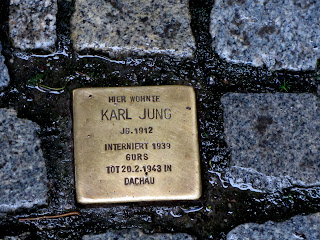Stolperstein is the German word meaning "stumbling block," "obstacle," or "something in the way." Stolperstein has now taken on the meaning of being a small plaque in the sidewalk. These plaques commemorate the former homes of victims of the Holocaust. They demarcate where Jews (and sometimes where other ethnic groups who were also persecuted) lived and were taken by the Nazis.
 |
Here lived
KARL JUNG
born 1912
Interned 1939
Gurs (concentration camp in Southwestern France)
Killed 20.2.1943 in
Dachau |
Today I went on a walking tour of Düsseldorf with the 8th grade Humanities classes. They have been studying the Holocaust and each group visited different parts of the city. It was a torrential downpour during most of the trip and we had to take a temporary and warm Starbucks break. But, the kids (and I) were really moved.
Many of the Stolperstein are in front of what are now businesses and some are still apartment buildings. They specifically marked where people lived and were taken. We spent a long time discussing how sickeningly scary it would be and what it would be like to be a neighbor of someone who was just taken from their life in such a sudden manner.
 |
Here lived
Franz Anselm
Cohen-Altmann
Born 1905
Deported 1942, Died in Izbica, Poland |
The kids placed flowers at each of the plaques. The language on the plaques is very plain. It states that they were murdered, as truly was the case.
 |
We inferred that this was a married couple.
Alfred & Meta Meyerstein
Deported 1941
Murdered in Minsk |
The next one was especially sad. This was likely a mother and daughter. And, the fact that it said they were "reported" (
auswiesen) lead us to believe that they were hiding but then found out and later murdered in Treblinka in Poland. This was in front of an apartment building that is still an apartment building. It is right along the Rhein River and one can assume this was likely a very expensive area to live then, just as it is now- given that it is water-front property. Pescha was only around 15 when she died and given that her neighbors just down the street were taken in 1933, we inferred that they were possible in hiding for five years.
 |
Reisel Laja & Pescha Birnbach
Reported 28.10.1938
Taken to a Ghetto
Murdered June 1942 in Treblinka |
 |
| Small but significant. |
At each Stolperstein, our directions were to look at the building and infer what it must have been before the war compared to now.
 |
| You can imagine people looking out that bay window as the people they'd been hiding were taken. |
These plaques are small and only provide an outline of information. But, they help us remember. They put a name and a place to someone's life that would otherwise be forgotten. It makes me so sad and at the same time makes me glad that we are still speaking those names and still remembering- the victims deserve at least this.
Just earlier this week there was an NPR story about Stolperstein.
Click
here to read/listen.






6 comments:
What an experience for these kids...
Are you willing to say no to students who will end up costing you more money in the long run?
dissertation sample size
Such a blaster information shared. Looks to me a great feature to make your website great to visit. Thanks
Postcard Design
Postcard Design
Thanks for the informative and helpful post, obviously in your blog everything is good. net worth
Post a Comment